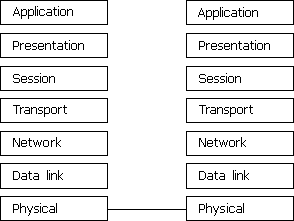
Windows 98 provides multiple, simultaneous connections to a variety of networks (Windows NT, Novell NetWare, and others) and a variety of resources (files, programs, printers, host systems, and mail systems) over most popular media (Ethernet, Token Ring, X.25, ATM, and ISDN) from almost any location.
Windows 98 networking capabilities are implemented using a high-performance, reliable, and open architecture based on the Windows Open Services Architecture (WOSA) specification. This approach provides users with a consistent interface to different services on the front end, while giving system administrators the flexibility to mix and match multiple services on the back end.
The modular networking architecture of Windows 98 is based on two industry standard models for a layered networking architecture, namely the International Standards Organization (ISO) model for computer networking, called the Open Systems Interconnection (OSI) Reference Model, and the Institute of Electrical and Electronics Engineers (IEEE) 802 model. Windows NT and Windows for Workgroups are also designed according to these standard models. The ISO OSI and IEEE 802 models define a modular approach to networking, with each layer responsible for some discrete aspect of the networking process. They are only models; they do not correspond exactly to any existing network. However, they can help you understand how networks function in general.
The OSI model describes the flow of data in a network, from the lowest layer (the physical connections) up to the layer containing the userís applications. Data going to and from the network is passed from layer to layer. Each layer is able to communicate with the layer immediately above it and the layer immediately below it. In this way, each layer is written as an efficient, streamlined software component. When a layer receives a packet of information, it checks the destination address, and if its own address is not there, it passes the packet to the next layer.
When two computers communicate on a network, the software at each layer on one computer assumes it is communicating with the same layer on the other computer. For example, the transport layer of one computer assumes that it is communicating directly with the transport layer on the other computer. However, the actual connection occurs only at the physical layer, as Figure 29.1 shows. The transport layer on the first computer has no regard for how the communication actually passes through the lower layers of the first computer, across the physical media, and then up through the lower layers of the second computer.
Figure 29.1 shows the OSI model.

Figure 29.1 Layers in the OSI Model
The OSI model includes seven layers:
The IEEE 802 model defines low-level protocol standards at the physical and data link layers of the OSI model, dividing the data link layer into two sublayers: logical link control (LLC) and media access control (MAC). Figure 29.2 compares the IEEE 802 model and the lower layers of the OSI model.

Figure 29.2 IEEE 802 model compared to the OSI model
The LLC sublayer performs the following tasks:
The MAC sublayer performs the following tasks:
Figure 29.3 shows the layered components that make up the Windows 98 networking model.

Figure 29.3 Windows 98 network architecture
These layers correspond roughly to the layers in the OSI model, as the following list describes:
The following sections describe these elements of the Windows 98 network architecture, beginning with redirectors. Network providers are described in "Multiple Network Support" later in this chapter.